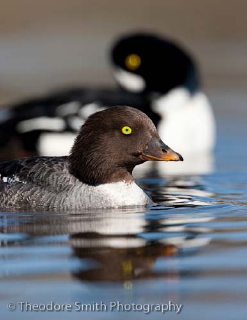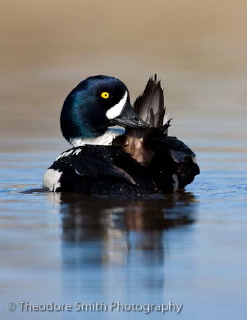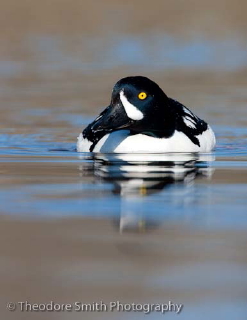Principal Investigators
Sean Boyd, Science
and Technology Branch, Environment Canada
5421 Robertson
Road, Delta, BC
Dan Esler, U.S. Geological Survey, Alaska Science Center, 4210 University Drive, Anchorage, AK and Centre
for Wildlife Ecology, Simon Fraser University
Research Partners
Tim Bowman, Sea Duck Joint Venture, U.S. Fish and Wildlife Service
1011 E. Tudor Rd., Anchorage, AK
Jonathan E. Thompson, Ducks Unlimited Canada
#200-10720 178 Street, Edmonton, AB
Jason Schamber, Alaska Department of Fish and Game
525 W. 67th Ave, Anchorage, AK
Background
Connectivity
among annual cycle stages, rates of site fidelity, and the geographic scale of
dispersal are largely unknown for Pacific Barrow’s Goldeneye (BAGO). This
precludes researchers from
identifying demographically discrete units for population management
and understanding the scale of inference from field studies. Further, habitats and specific sites that may
be particularly important for BAGO are difficult to identify, as this species
is not well covered by surveys for most of its annual cycle and range.
This
project aims to fill the above information gaps by using
satellite
telemetry. More specifically,
our
research addresses the following questions:
1) What are the rates, and geographic scale, of
inter-annual site fidelity by all sex and age classes at various stages
of the annual cycle?
2) Do birds from the same breeding site occur in
discrete areas during winter, or are they widely distributed, and vice
versa?
3) How do the answers to 1 and 2 above combine to
indicate demographically distinct management units?
4)
Are there important habitats or specific sites
that are used by a large
proportion of marked birds, which would indicate their
value for
conservation?
From 2006 to 2012, we deployed 267 satellite transmitters (PTTs) on
BAGO at five sites as described in the table below and shown in the maps. Follow
the links at the top of this page to view maps depicting the migratory routes of BAGO tagged at
each site. Maps describing individual migrations and cohort summaries are presented.
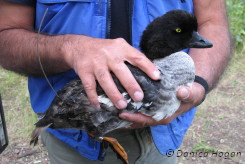 | 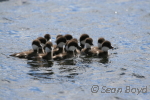 | 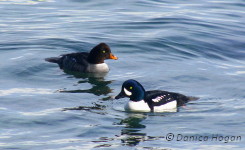
| | A tagged adult female | BAGO hatchlings | BAGO adult female and male |
| | Recent News~
Information presented on these sites include data processed up to
August 2011. Scroll through the entries below for bi-monthly updates on
BAGO movements + interesting observations since the date above ~ 12-07-2012- The BAGO dataset has been uploaded to Movebank
- a free, online database of animal tracking data. New locations will
continually be imported to Movebank via a livefeed from Argos,
approximately every 6 hours. Please note that while the data on Movebank are automatically filtered (using the Douglas Argos Filter)
upon import, they have not been manually checked for erroneous
locations which can still be present in the dataset post-filtering.
Please refer to the maps on this website for the most accurate
migration route information.
29-06-2012
- There
have been 2 mortalities in the last week: One is a SY female (115695),
on the SW corner of Douglas Island; the other is an adult male
(115697), north of 67° latitude.
27-06-2012
- Almost all males tagged in Juneau are forming a
large cluster about 300km NW of Great Bear Lk NT.
- The south BC BAGOs are showing some interesting patterns lately: Two adult males are on Cardinal Lk; one
bird (33881) was banded on CL in 2010, and the other (40052) was banded
in Indian Arm in 2011, and this last bird was hanging out at Riske Ck
for the last 3 weeks (indicating that it's a small world, and suggesting a
strong connection between IA-RC-CL).
- Two males are on Utikuma Lake AB, about
150km east of Cardinal Lk: one male (108556) is a subadult bird marked
at Riske Ck in 2011, and the other (39834) is an adult male marked at
Indian Arm in 2011 (adding another piece to the IA-RC-CL puzzle).
- A subadult female banded at Riske last year (108565), is way up in northern BC; a
subadult male (40396) is even further to the north, probably
molting on Racoon Lk, just north of Great Slave Lk NT.
20-06-2012
Juneau BAGOs:
- 10 to 11 adult males have moved to wetlands north of 65° latitude (in fact, all PTT IDs
north of this latitude are males).
- One male (115682) is now on the coast
of the Beaufort Sea. Some Surf Scoters are known to do this but this is
the first time a marked Pacific BAGO has been tracked to the Arctic
Ocean.
- Some adult hens may be
incubating clutches inside cavities because they are not signaling (i.e.,
the satellites are not detecting them) or their signals are of poor
quality.
South BAGOs:
- These birds haven't moved much in recent weeks.
- The one juvenile male (marked at Riske
Ck last summer) that migrated north to NT a week ago has moved even
further north…maybe he'll keep going until he hits the Beaufort Sea!
- At least one male marked at Cardinal
Lk in 2010 has returned to that lake to molt, and it looks like at least
one other male is on his way there. 11-06-2012
Juneau BAGOs:
- There has been plenty of movement in
recent days, mostly males moving from breeding areas to molting areas, some to the west and NW of Great Bear Lk in NT. I had anticipated that some of the Juneau males would molt at Old Crow Flats YK, but that hasn't happened yet.
- Two pairs (of the original 3) are
still together; male 40398 left his mate a while ago, and is now just
west of Great Bear Lk.
South BAGOs:
- Not a lot has changed since the last
update: Three sub-adult females have returned to Riske Ck to check out their
natal ponds, and have remained there. PWS BAGO:
- Interesting to note that a male BAGO marked in Prince William Sound AK in March 2009
has come back on line after not having signalled for a few months
(weird!), and he is back at his old breeding area. We now have 4 annual
cycles for this male, which is pretty incredible for a battery that was
supposed to last only 2 years. 09-06-2012
Juneau BAGOs:
- Roughly half of the marked BAGOs have migrated north/northeast and
most of these are in the Yukon now. The other half (14-15 birds)
are still within 50km of Juneau, but likely will depart soon.
- Two of the three marked pairs are still moving together.
South BAGOs:
- There has been minimal movement since the last entry; most adult birds have now settled on their breeding sites.
- Several birds are located just south of Kamloops, including individuals makred at Indian Arm BC (Apr 2011) and Cardinal Lk AB (Aug 2010).
- Most of the juvenile BAGOs are still on the coast. 05-05-2012
Juneau BAGOs:
-
Migration has started in earnest in the last few days, and most birds
are moving to the north and north-east. Some individuals have moved
500-600 km already (that's about 300-400 miles).
- At least 2 of the 3 known pairs are still moving together.
South BAGOs:
- Adult migration started 1-2 weeks ago (earlier than the Juneau birds, which makes sense
cause of latitude differences).
- Juvenile migration has just begun, but a few individuals are still on
the coast; it's going to be interesting to see where the 5 juvenile (1st
yr) females in this group end up in a few weeks.
- Many of the
adult birds are staging and possibly attempting to nest
around Kamloops, BC (similar to previous years).
29-04-2012
Juneau BAGOs:
- As of today,
33 of the 34 marked birds are signaling, and their temperature sensors
indicate that all 33 are alive and well. There has already been some movement of >100km by some
individuals; however most movement has been local. Also, of the 3 pairs
we were able to mark, 2 are migrating together: one pair is on Admiralty
Island, and the other has migrated 100 km to the northeast. South BAGOs:
- About 18-20 birds are still signalling, divided roughly equally
between the 3 capture sites.
- Many of the HY birds marked at Riske Ck in Aug 2011
were predated on or near their natal ponds or, for those that made it
to the coast, on their winter grounds. None of these HY (actually SY
birds now) have left their coastal winter sites yet.
- Most of the Indian
Arm AHY males/females and Cardinal Lk AHY males have departed from the
coast and have moved to the BC interior. A cluster of the IA birds are
near Kamloops BC, similar to last year at this same time. A few IA birds
are still in Indian Arm, but we expect them to be moving on soon. 18-04-2012
-
Thirty-four new BAGOs are being tracked! Over the past 10 days we
banded 100 sea ducks, including 66 BAGOs, in Juneau, AK. Of these, we
tagged 34 BAGOs, including 22 males and 12 females, of which 10 were
AHYs and 2 were SYs. Many thanks to the field crew for a job well
done! |
Capture sites
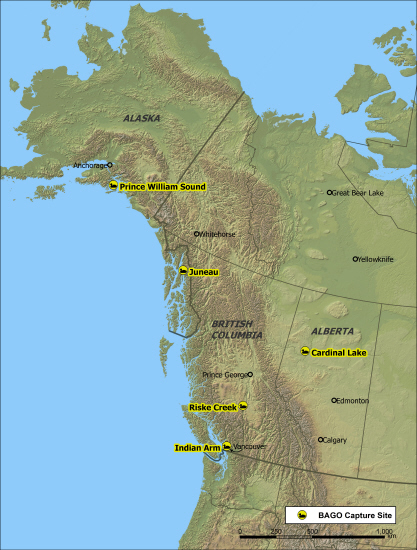
|
| Location | Season | Age + Sex | Month | Years |
| Riske Creek, BC | Breeding | Adult males | May | 2006, 2007, 2008 | | | Adult females | Jul | 2008, 2009 | | | Hatch-Year males + females | Jul, Aug | 2008, 2009, 2011 |
| Indian Arm, BC | Wintering | Adult males + females | Feb, Apr | 2007, 2011 |
| Cardinal Lake, AB | Molting | Adult males | Aug | 2009, 2010 |
| Prince William Sound, AK | Wintering | Adult males + females | Mar | 2009 |
| Juneau, AK | Wintering | Adult males + females | Apr | 2012 |
Acknowledgements
We
thank the following individuals for their time and help during
captures: Eric Anderson, David Bradbeer, Rob Butler, Anthony Crupi, Shanti
Davis, Rian Dickson, Ty Donnelly, Garry Grigg, Debbie Groves, Sharon
Henry, Ryan Hermanutz, Danica Hogan, Jerry Hupp, Joe and Ellie Jaschke and family,
Justin Jenniges, Rod MacVicar, Jamie McDonald, Rod MacVicar, Mark Maftei, Dennis Marks, Mike
Merriam, James Olsen, Eric Palm, Mike Petrula, Julie Pierce, Jennifer
Provencher, Dean Rand, Chad Rice, John Reed, Andrew Robinson, Dan Rosenberg, Jason Schamber, Ryan Scott, Dan Shervill,
Robb Stavne, Krystal Tangen, Brian Uher-Koch, Corey Van Stratt,
Melanie Wilson,
Ken Wright, Chris Wohl, and Robyn Worcester.
We
thank the Canadian Dept. of National Defense for access to their
training area at Riske Creek, BC, and Rod MacVicar for allowing us to
use the Reed Point Marine Education Centre facilities to conduct
surgeries.
Surgery and Veterinarian Services: Dr. Malcolm McAdie, DVM and Dr. Dan Mulcahy, DVM
Data download and storage: Sandi Lee, CWS, Environment Canada
Map creation, spatial analysis, and website design: Jennifer Barrett, Centre for Wildlife Ecology
Photo credits: Ted Smith, Theodore Smith Photography (website); Danica Hogan, Centre for Wildlife Ecology; Sean Boyd, Science
and Technology Branch, Environment Canada
This
study is dedicated to Jean-Pierre Savard (JPS) and Garry Grigg (GG).
JPS studied the territorial behavior of Pacific Barrow's Goldeneye and
often speculated on their post-breeding movements. GG was instrumental
in developing capture techniques on both the breeding and wintering
grounds.
The following agencies provided funding and/or support for the project: |
|
